Navigating Ethical Dilemmas in Indigenous Youth Community Work
VerifiedAdded on 2020/05/08
|8
|2224
|576
Essay
AI Summary
The essay critically analyses an ethical dilemma encountered by a community development worker in Australia, tasked with improving outcomes for Indigenous youth at risk of entering the criminal justice system. The analysis involves understanding two main perspectives: ethical intuitionism and rule utilitarianism. Ethical intuitionism suggests it might be ethically permissible to build personal relationships with community members, potentially breaking formal rules to achieve better results. In contrast, rule utilitarianism emphasizes adherence to established rules that promote the greatest good for the community as a whole. The essay concludes that while ethical intuitionism may justify rule-breaking in certain situations, rule utilitarianism and adherence to professional ethics are crucial given the alarming rate of Indigenous youth involvement in crime. The necessity for evidence-based strategies within professional boundaries is highlighted to ensure sustainable development.
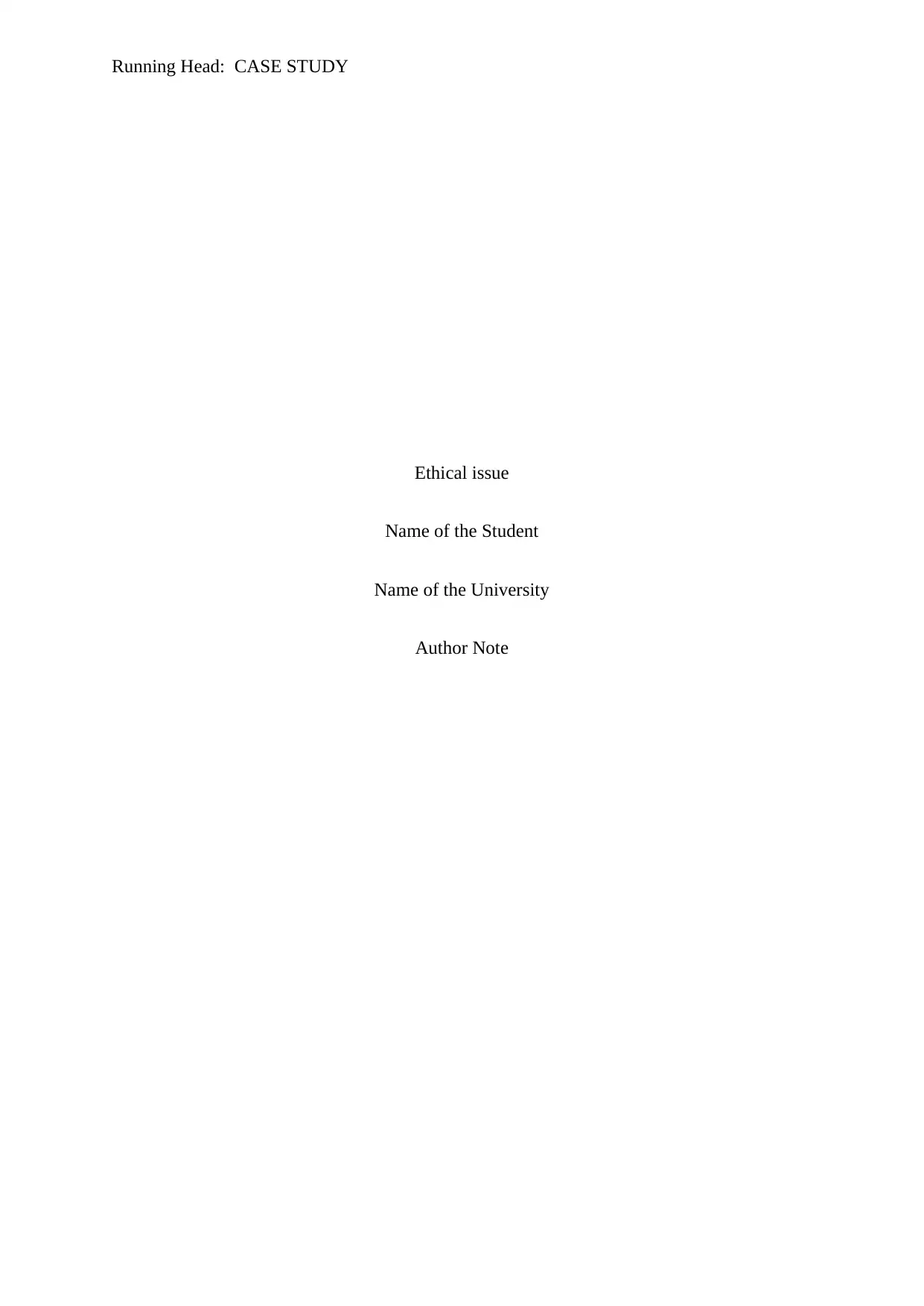
Running Head: CASE STUDY
Ethical issue
Name of the Student
Name of the University
Author Note
Ethical issue
Name of the Student
Name of the University
Author Note
Paraphrase This Document
Need a fresh take? Get an instant paraphrase of this document with our AI Paraphraser
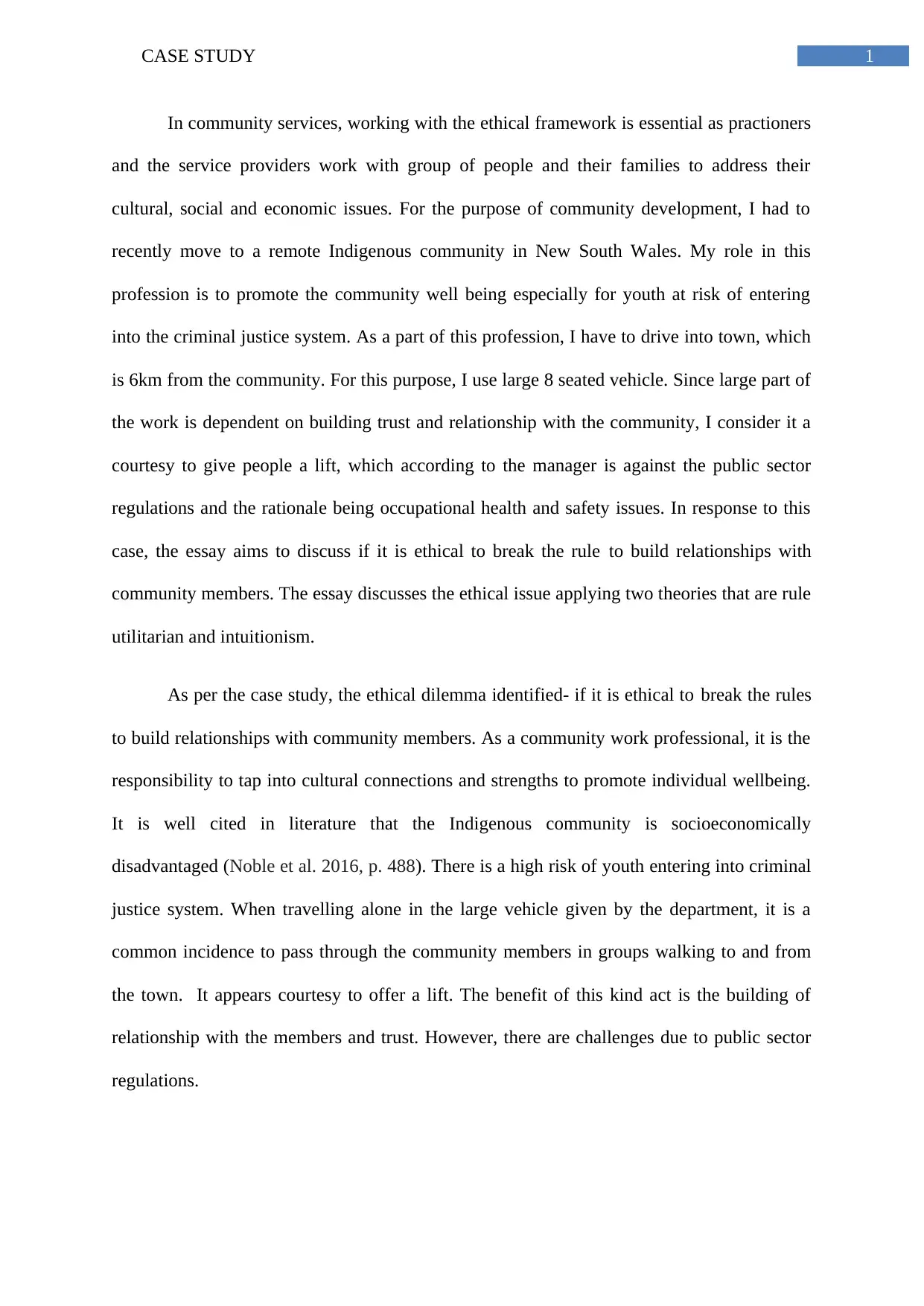
1CASE STUDY
In community services, working with the ethical framework is essential as practioners
and the service providers work with group of people and their families to address their
cultural, social and economic issues. For the purpose of community development, I had to
recently move to a remote Indigenous community in New South Wales. My role in this
profession is to promote the community well being especially for youth at risk of entering
into the criminal justice system. As a part of this profession, I have to drive into town, which
is 6km from the community. For this purpose, I use large 8 seated vehicle. Since large part of
the work is dependent on building trust and relationship with the community, I consider it a
courtesy to give people a lift, which according to the manager is against the public sector
regulations and the rationale being occupational health and safety issues. In response to this
case, the essay aims to discuss if it is ethical to break the rule to build relationships with
community members. The essay discusses the ethical issue applying two theories that are rule
utilitarian and intuitionism.
As per the case study, the ethical dilemma identified- if it is ethical to break the rules
to build relationships with community members. As a community work professional, it is the
responsibility to tap into cultural connections and strengths to promote individual wellbeing.
It is well cited in literature that the Indigenous community is socioeconomically
disadvantaged (Noble et al. 2016, p. 488). There is a high risk of youth entering into criminal
justice system. When travelling alone in the large vehicle given by the department, it is a
common incidence to pass through the community members in groups walking to and from
the town. It appears courtesy to offer a lift. The benefit of this kind act is the building of
relationship with the members and trust. However, there are challenges due to public sector
regulations.
In community services, working with the ethical framework is essential as practioners
and the service providers work with group of people and their families to address their
cultural, social and economic issues. For the purpose of community development, I had to
recently move to a remote Indigenous community in New South Wales. My role in this
profession is to promote the community well being especially for youth at risk of entering
into the criminal justice system. As a part of this profession, I have to drive into town, which
is 6km from the community. For this purpose, I use large 8 seated vehicle. Since large part of
the work is dependent on building trust and relationship with the community, I consider it a
courtesy to give people a lift, which according to the manager is against the public sector
regulations and the rationale being occupational health and safety issues. In response to this
case, the essay aims to discuss if it is ethical to break the rule to build relationships with
community members. The essay discusses the ethical issue applying two theories that are rule
utilitarian and intuitionism.
As per the case study, the ethical dilemma identified- if it is ethical to break the rules
to build relationships with community members. As a community work professional, it is the
responsibility to tap into cultural connections and strengths to promote individual wellbeing.
It is well cited in literature that the Indigenous community is socioeconomically
disadvantaged (Noble et al. 2016, p. 488). There is a high risk of youth entering into criminal
justice system. When travelling alone in the large vehicle given by the department, it is a
common incidence to pass through the community members in groups walking to and from
the town. It appears courtesy to offer a lift. The benefit of this kind act is the building of
relationship with the members and trust. However, there are challenges due to public sector
regulations.
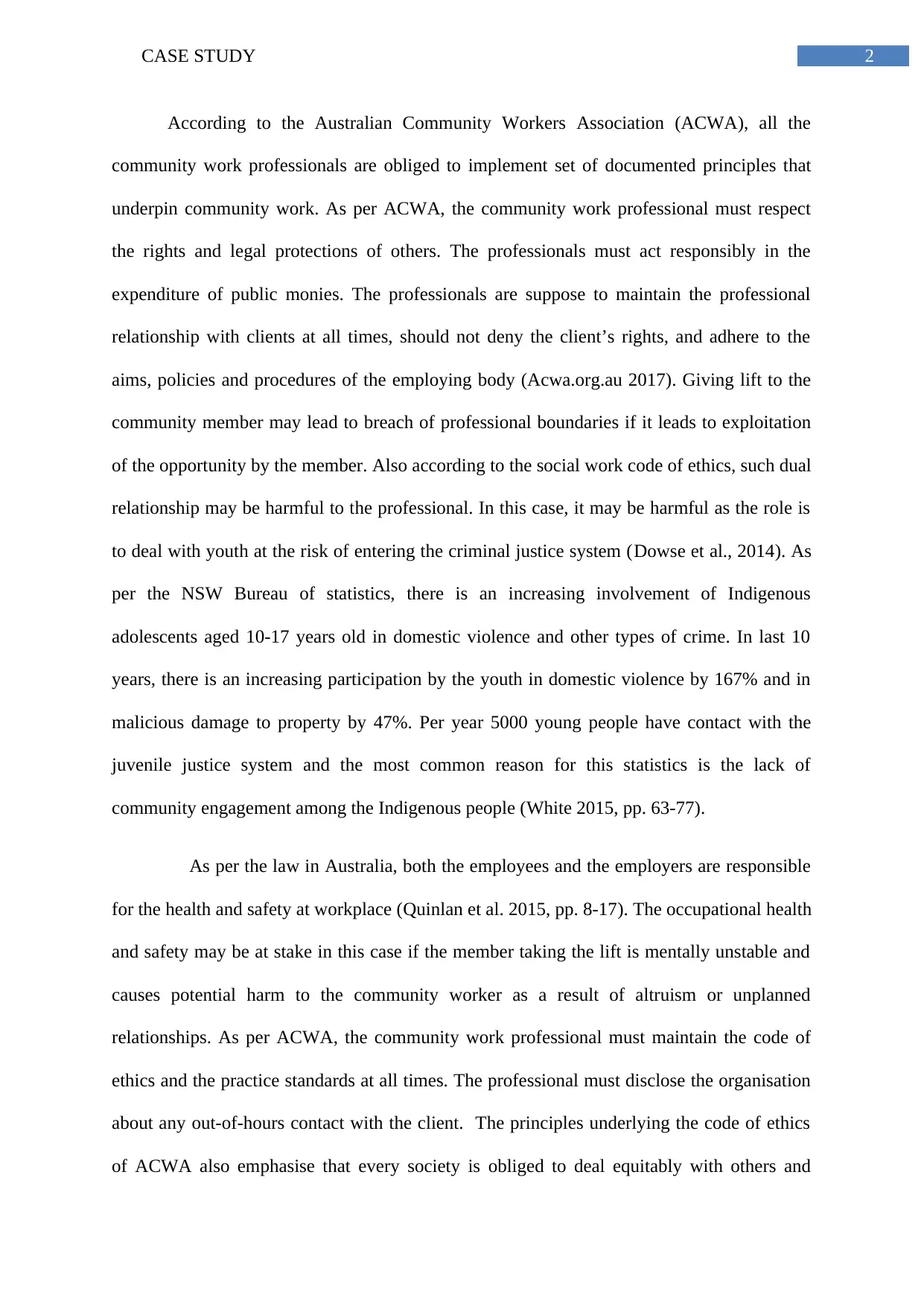
2CASE STUDY
According to the Australian Community Workers Association (ACWA), all the
community work professionals are obliged to implement set of documented principles that
underpin community work. As per ACWA, the community work professional must respect
the rights and legal protections of others. The professionals must act responsibly in the
expenditure of public monies. The professionals are suppose to maintain the professional
relationship with clients at all times, should not deny the client’s rights, and adhere to the
aims, policies and procedures of the employing body (Acwa.org.au 2017). Giving lift to the
community member may lead to breach of professional boundaries if it leads to exploitation
of the opportunity by the member. Also according to the social work code of ethics, such dual
relationship may be harmful to the professional. In this case, it may be harmful as the role is
to deal with youth at the risk of entering the criminal justice system (Dowse et al., 2014). As
per the NSW Bureau of statistics, there is an increasing involvement of Indigenous
adolescents aged 10-17 years old in domestic violence and other types of crime. In last 10
years, there is an increasing participation by the youth in domestic violence by 167% and in
malicious damage to property by 47%. Per year 5000 young people have contact with the
juvenile justice system and the most common reason for this statistics is the lack of
community engagement among the Indigenous people (White 2015, pp. 63-77).
As per the law in Australia, both the employees and the employers are responsible
for the health and safety at workplace (Quinlan et al. 2015, pp. 8-17). The occupational health
and safety may be at stake in this case if the member taking the lift is mentally unstable and
causes potential harm to the community worker as a result of altruism or unplanned
relationships. As per ACWA, the community work professional must maintain the code of
ethics and the practice standards at all times. The professional must disclose the organisation
about any out-of-hours contact with the client. The principles underlying the code of ethics
of ACWA also emphasise that every society is obliged to deal equitably with others and
According to the Australian Community Workers Association (ACWA), all the
community work professionals are obliged to implement set of documented principles that
underpin community work. As per ACWA, the community work professional must respect
the rights and legal protections of others. The professionals must act responsibly in the
expenditure of public monies. The professionals are suppose to maintain the professional
relationship with clients at all times, should not deny the client’s rights, and adhere to the
aims, policies and procedures of the employing body (Acwa.org.au 2017). Giving lift to the
community member may lead to breach of professional boundaries if it leads to exploitation
of the opportunity by the member. Also according to the social work code of ethics, such dual
relationship may be harmful to the professional. In this case, it may be harmful as the role is
to deal with youth at the risk of entering the criminal justice system (Dowse et al., 2014). As
per the NSW Bureau of statistics, there is an increasing involvement of Indigenous
adolescents aged 10-17 years old in domestic violence and other types of crime. In last 10
years, there is an increasing participation by the youth in domestic violence by 167% and in
malicious damage to property by 47%. Per year 5000 young people have contact with the
juvenile justice system and the most common reason for this statistics is the lack of
community engagement among the Indigenous people (White 2015, pp. 63-77).
As per the law in Australia, both the employees and the employers are responsible
for the health and safety at workplace (Quinlan et al. 2015, pp. 8-17). The occupational health
and safety may be at stake in this case if the member taking the lift is mentally unstable and
causes potential harm to the community worker as a result of altruism or unplanned
relationships. As per ACWA, the community work professional must maintain the code of
ethics and the practice standards at all times. The professional must disclose the organisation
about any out-of-hours contact with the client. The principles underlying the code of ethics
of ACWA also emphasise that every society is obliged to deal equitably with others and
⊘ This is a preview!⊘
Do you want full access?
Subscribe today to unlock all pages.

Trusted by 1+ million students worldwide
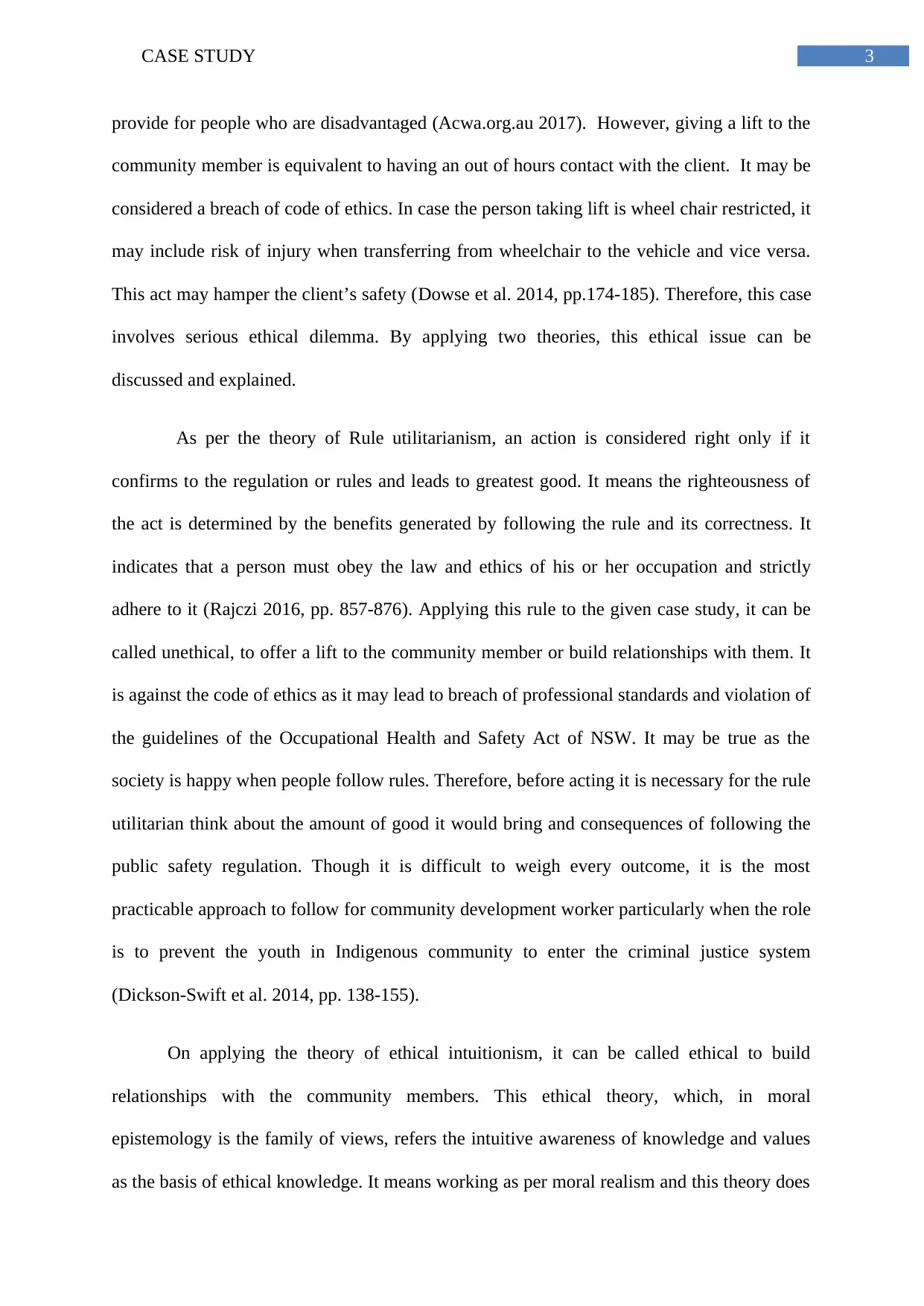
3CASE STUDY
provide for people who are disadvantaged (Acwa.org.au 2017). However, giving a lift to the
community member is equivalent to having an out of hours contact with the client. It may be
considered a breach of code of ethics. In case the person taking lift is wheel chair restricted, it
may include risk of injury when transferring from wheelchair to the vehicle and vice versa.
This act may hamper the client’s safety (Dowse et al. 2014, pp.174-185). Therefore, this case
involves serious ethical dilemma. By applying two theories, this ethical issue can be
discussed and explained.
As per the theory of Rule utilitarianism, an action is considered right only if it
confirms to the regulation or rules and leads to greatest good. It means the righteousness of
the act is determined by the benefits generated by following the rule and its correctness. It
indicates that a person must obey the law and ethics of his or her occupation and strictly
adhere to it (Rajczi 2016, pp. 857-876). Applying this rule to the given case study, it can be
called unethical, to offer a lift to the community member or build relationships with them. It
is against the code of ethics as it may lead to breach of professional standards and violation of
the guidelines of the Occupational Health and Safety Act of NSW. It may be true as the
society is happy when people follow rules. Therefore, before acting it is necessary for the rule
utilitarian think about the amount of good it would bring and consequences of following the
public safety regulation. Though it is difficult to weigh every outcome, it is the most
practicable approach to follow for community development worker particularly when the role
is to prevent the youth in Indigenous community to enter the criminal justice system
(Dickson-Swift et al. 2014, pp. 138-155).
On applying the theory of ethical intuitionism, it can be called ethical to build
relationships with the community members. This ethical theory, which, in moral
epistemology is the family of views, refers the intuitive awareness of knowledge and values
as the basis of ethical knowledge. It means working as per moral realism and this theory does
provide for people who are disadvantaged (Acwa.org.au 2017). However, giving a lift to the
community member is equivalent to having an out of hours contact with the client. It may be
considered a breach of code of ethics. In case the person taking lift is wheel chair restricted, it
may include risk of injury when transferring from wheelchair to the vehicle and vice versa.
This act may hamper the client’s safety (Dowse et al. 2014, pp.174-185). Therefore, this case
involves serious ethical dilemma. By applying two theories, this ethical issue can be
discussed and explained.
As per the theory of Rule utilitarianism, an action is considered right only if it
confirms to the regulation or rules and leads to greatest good. It means the righteousness of
the act is determined by the benefits generated by following the rule and its correctness. It
indicates that a person must obey the law and ethics of his or her occupation and strictly
adhere to it (Rajczi 2016, pp. 857-876). Applying this rule to the given case study, it can be
called unethical, to offer a lift to the community member or build relationships with them. It
is against the code of ethics as it may lead to breach of professional standards and violation of
the guidelines of the Occupational Health and Safety Act of NSW. It may be true as the
society is happy when people follow rules. Therefore, before acting it is necessary for the rule
utilitarian think about the amount of good it would bring and consequences of following the
public safety regulation. Though it is difficult to weigh every outcome, it is the most
practicable approach to follow for community development worker particularly when the role
is to prevent the youth in Indigenous community to enter the criminal justice system
(Dickson-Swift et al. 2014, pp. 138-155).
On applying the theory of ethical intuitionism, it can be called ethical to build
relationships with the community members. This ethical theory, which, in moral
epistemology is the family of views, refers the intuitive awareness of knowledge and values
as the basis of ethical knowledge. It means working as per moral realism and this theory does
Paraphrase This Document
Need a fresh take? Get an instant paraphrase of this document with our AI Paraphraser
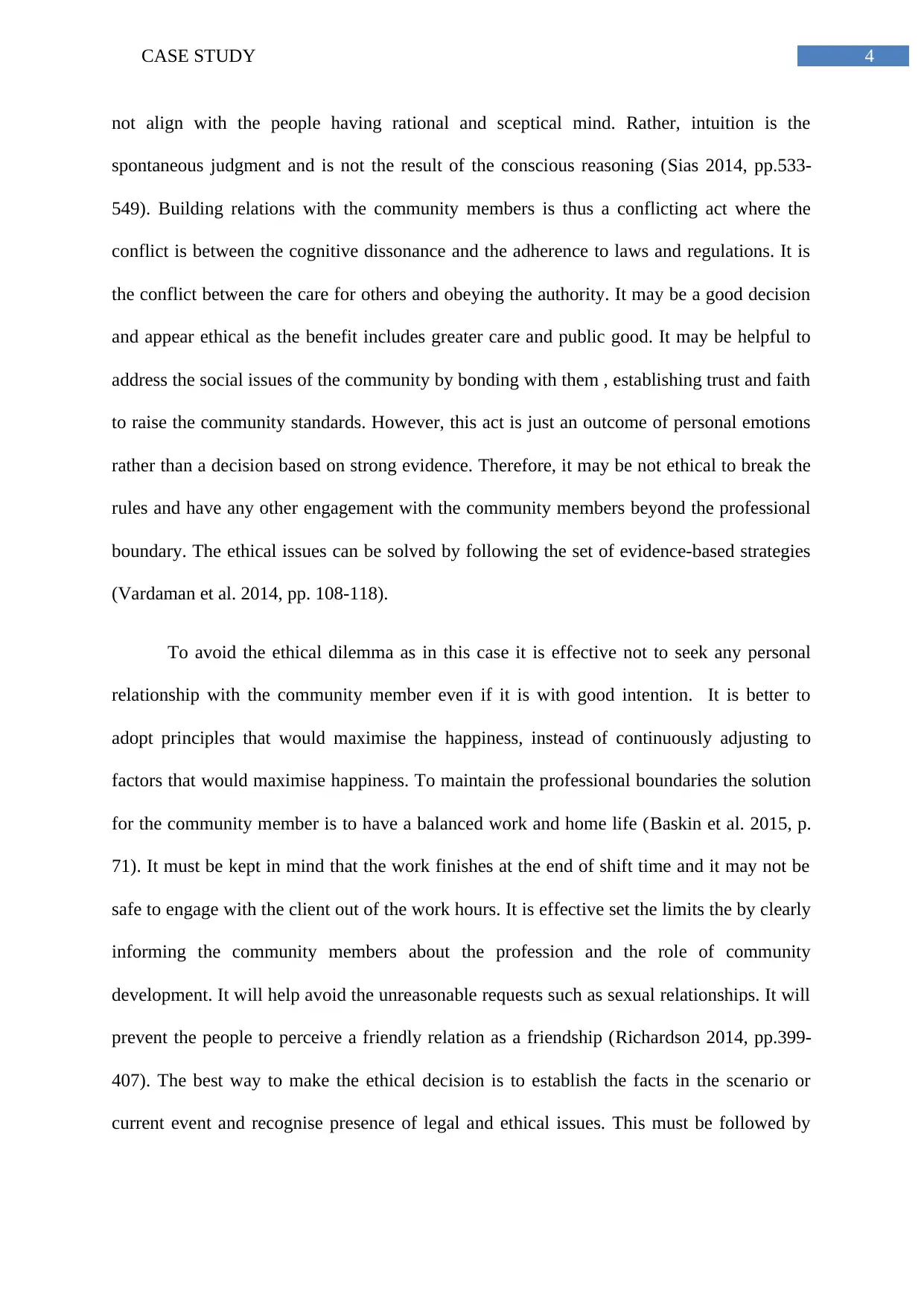
4CASE STUDY
not align with the people having rational and sceptical mind. Rather, intuition is the
spontaneous judgment and is not the result of the conscious reasoning (Sias 2014, pp.533-
549). Building relations with the community members is thus a conflicting act where the
conflict is between the cognitive dissonance and the adherence to laws and regulations. It is
the conflict between the care for others and obeying the authority. It may be a good decision
and appear ethical as the benefit includes greater care and public good. It may be helpful to
address the social issues of the community by bonding with them , establishing trust and faith
to raise the community standards. However, this act is just an outcome of personal emotions
rather than a decision based on strong evidence. Therefore, it may be not ethical to break the
rules and have any other engagement with the community members beyond the professional
boundary. The ethical issues can be solved by following the set of evidence-based strategies
(Vardaman et al. 2014, pp. 108-118).
To avoid the ethical dilemma as in this case it is effective not to seek any personal
relationship with the community member even if it is with good intention. It is better to
adopt principles that would maximise the happiness, instead of continuously adjusting to
factors that would maximise happiness. To maintain the professional boundaries the solution
for the community member is to have a balanced work and home life (Baskin et al. 2015, p.
71). It must be kept in mind that the work finishes at the end of shift time and it may not be
safe to engage with the client out of the work hours. It is effective set the limits the by clearly
informing the community members about the profession and the role of community
development. It will help avoid the unreasonable requests such as sexual relationships. It will
prevent the people to perceive a friendly relation as a friendship (Richardson 2014, pp.399-
407). The best way to make the ethical decision is to establish the facts in the scenario or
current event and recognise presence of legal and ethical issues. This must be followed by
not align with the people having rational and sceptical mind. Rather, intuition is the
spontaneous judgment and is not the result of the conscious reasoning (Sias 2014, pp.533-
549). Building relations with the community members is thus a conflicting act where the
conflict is between the cognitive dissonance and the adherence to laws and regulations. It is
the conflict between the care for others and obeying the authority. It may be a good decision
and appear ethical as the benefit includes greater care and public good. It may be helpful to
address the social issues of the community by bonding with them , establishing trust and faith
to raise the community standards. However, this act is just an outcome of personal emotions
rather than a decision based on strong evidence. Therefore, it may be not ethical to break the
rules and have any other engagement with the community members beyond the professional
boundary. The ethical issues can be solved by following the set of evidence-based strategies
(Vardaman et al. 2014, pp. 108-118).
To avoid the ethical dilemma as in this case it is effective not to seek any personal
relationship with the community member even if it is with good intention. It is better to
adopt principles that would maximise the happiness, instead of continuously adjusting to
factors that would maximise happiness. To maintain the professional boundaries the solution
for the community member is to have a balanced work and home life (Baskin et al. 2015, p.
71). It must be kept in mind that the work finishes at the end of shift time and it may not be
safe to engage with the client out of the work hours. It is effective set the limits the by clearly
informing the community members about the profession and the role of community
development. It will help avoid the unreasonable requests such as sexual relationships. It will
prevent the people to perceive a friendly relation as a friendship (Richardson 2014, pp.399-
407). The best way to make the ethical decision is to establish the facts in the scenario or
current event and recognise presence of legal and ethical issues. This must be followed by
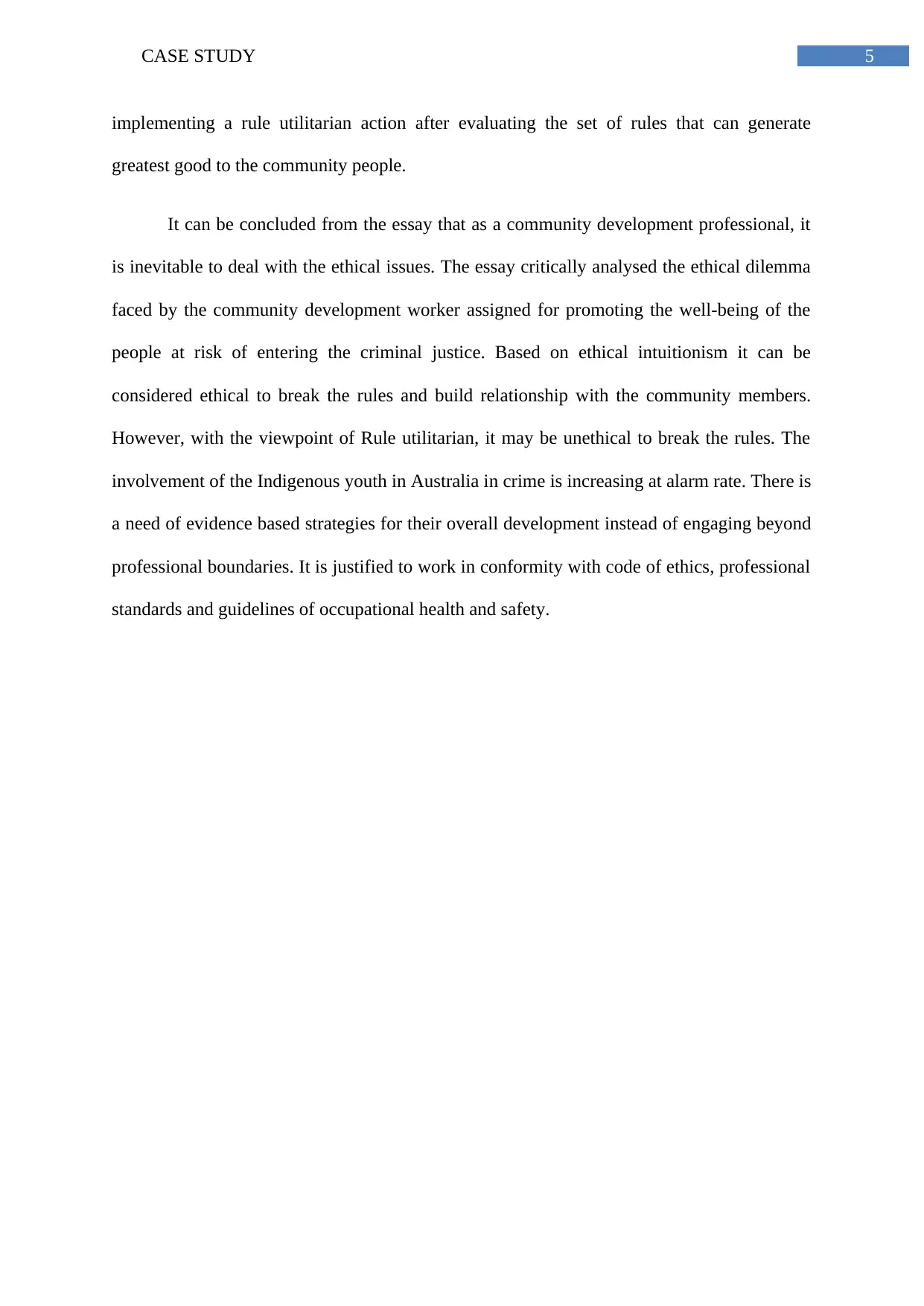
5CASE STUDY
implementing a rule utilitarian action after evaluating the set of rules that can generate
greatest good to the community people.
It can be concluded from the essay that as a community development professional, it
is inevitable to deal with the ethical issues. The essay critically analysed the ethical dilemma
faced by the community development worker assigned for promoting the well-being of the
people at risk of entering the criminal justice. Based on ethical intuitionism it can be
considered ethical to break the rules and build relationship with the community members.
However, with the viewpoint of Rule utilitarian, it may be unethical to break the rules. The
involvement of the Indigenous youth in Australia in crime is increasing at alarm rate. There is
a need of evidence based strategies for their overall development instead of engaging beyond
professional boundaries. It is justified to work in conformity with code of ethics, professional
standards and guidelines of occupational health and safety.
implementing a rule utilitarian action after evaluating the set of rules that can generate
greatest good to the community people.
It can be concluded from the essay that as a community development professional, it
is inevitable to deal with the ethical issues. The essay critically analysed the ethical dilemma
faced by the community development worker assigned for promoting the well-being of the
people at risk of entering the criminal justice. Based on ethical intuitionism it can be
considered ethical to break the rules and build relationship with the community members.
However, with the viewpoint of Rule utilitarian, it may be unethical to break the rules. The
involvement of the Indigenous youth in Australia in crime is increasing at alarm rate. There is
a need of evidence based strategies for their overall development instead of engaging beyond
professional boundaries. It is justified to work in conformity with code of ethics, professional
standards and guidelines of occupational health and safety.
⊘ This is a preview!⊘
Do you want full access?
Subscribe today to unlock all pages.

Trusted by 1+ million students worldwide
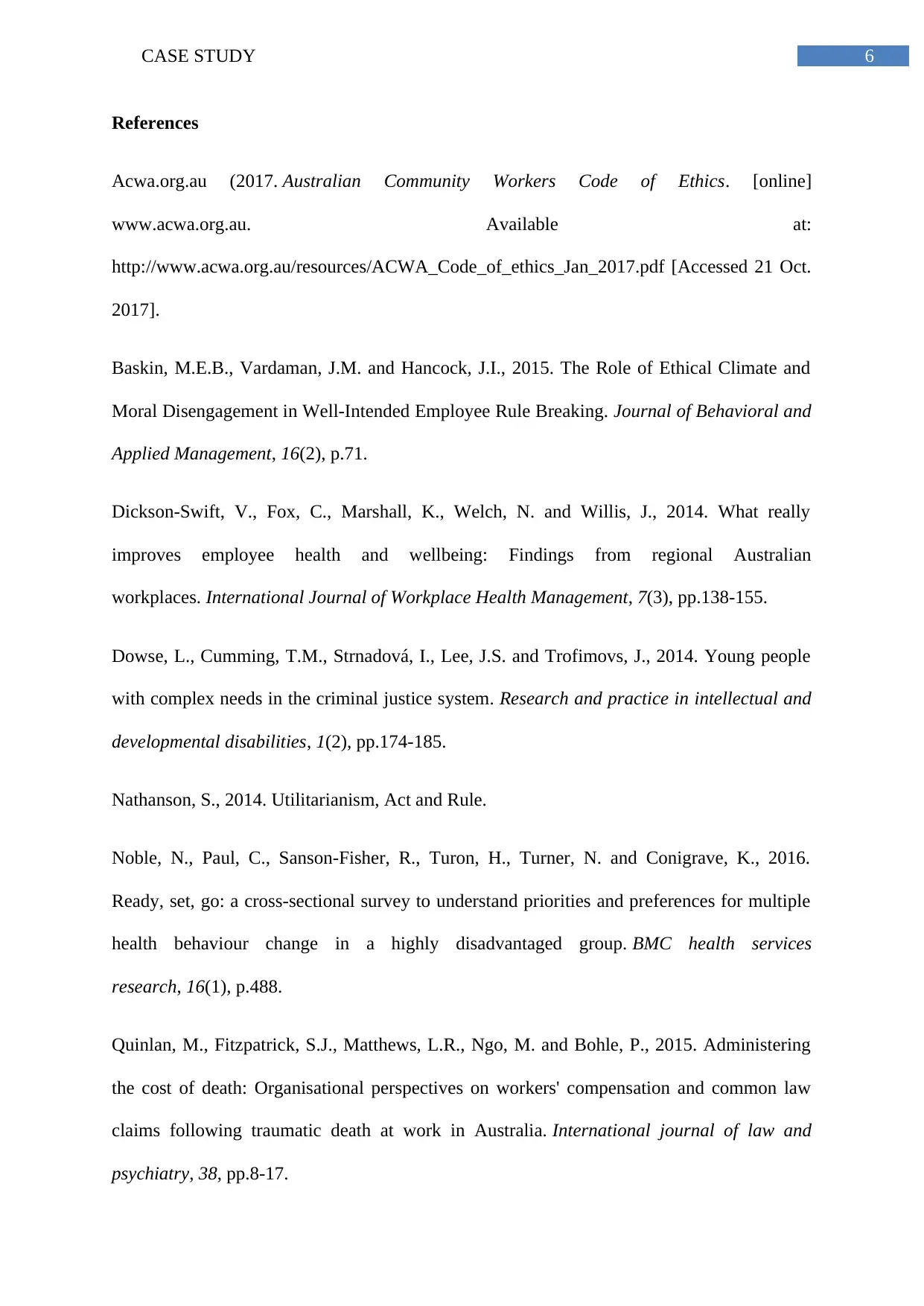
6CASE STUDY
References
Acwa.org.au (2017. Australian Community Workers Code of Ethics. [online]
www.acwa.org.au. Available at:
http://www.acwa.org.au/resources/ACWA_Code_of_ethics_Jan_2017.pdf [Accessed 21 Oct.
2017].
Baskin, M.E.B., Vardaman, J.M. and Hancock, J.I., 2015. The Role of Ethical Climate and
Moral Disengagement in Well-Intended Employee Rule Breaking. Journal of Behavioral and
Applied Management, 16(2), p.71.
Dickson-Swift, V., Fox, C., Marshall, K., Welch, N. and Willis, J., 2014. What really
improves employee health and wellbeing: Findings from regional Australian
workplaces. International Journal of Workplace Health Management, 7(3), pp.138-155.
Dowse, L., Cumming, T.M., Strnadová, I., Lee, J.S. and Trofimovs, J., 2014. Young people
with complex needs in the criminal justice system. Research and practice in intellectual and
developmental disabilities, 1(2), pp.174-185.
Nathanson, S., 2014. Utilitarianism, Act and Rule.
Noble, N., Paul, C., Sanson-Fisher, R., Turon, H., Turner, N. and Conigrave, K., 2016.
Ready, set, go: a cross-sectional survey to understand priorities and preferences for multiple
health behaviour change in a highly disadvantaged group. BMC health services
research, 16(1), p.488.
Quinlan, M., Fitzpatrick, S.J., Matthews, L.R., Ngo, M. and Bohle, P., 2015. Administering
the cost of death: Organisational perspectives on workers' compensation and common law
claims following traumatic death at work in Australia. International journal of law and
psychiatry, 38, pp.8-17.
References
Acwa.org.au (2017. Australian Community Workers Code of Ethics. [online]
www.acwa.org.au. Available at:
http://www.acwa.org.au/resources/ACWA_Code_of_ethics_Jan_2017.pdf [Accessed 21 Oct.
2017].
Baskin, M.E.B., Vardaman, J.M. and Hancock, J.I., 2015. The Role of Ethical Climate and
Moral Disengagement in Well-Intended Employee Rule Breaking. Journal of Behavioral and
Applied Management, 16(2), p.71.
Dickson-Swift, V., Fox, C., Marshall, K., Welch, N. and Willis, J., 2014. What really
improves employee health and wellbeing: Findings from regional Australian
workplaces. International Journal of Workplace Health Management, 7(3), pp.138-155.
Dowse, L., Cumming, T.M., Strnadová, I., Lee, J.S. and Trofimovs, J., 2014. Young people
with complex needs in the criminal justice system. Research and practice in intellectual and
developmental disabilities, 1(2), pp.174-185.
Nathanson, S., 2014. Utilitarianism, Act and Rule.
Noble, N., Paul, C., Sanson-Fisher, R., Turon, H., Turner, N. and Conigrave, K., 2016.
Ready, set, go: a cross-sectional survey to understand priorities and preferences for multiple
health behaviour change in a highly disadvantaged group. BMC health services
research, 16(1), p.488.
Quinlan, M., Fitzpatrick, S.J., Matthews, L.R., Ngo, M. and Bohle, P., 2015. Administering
the cost of death: Organisational perspectives on workers' compensation and common law
claims following traumatic death at work in Australia. International journal of law and
psychiatry, 38, pp.8-17.
Paraphrase This Document
Need a fresh take? Get an instant paraphrase of this document with our AI Paraphraser
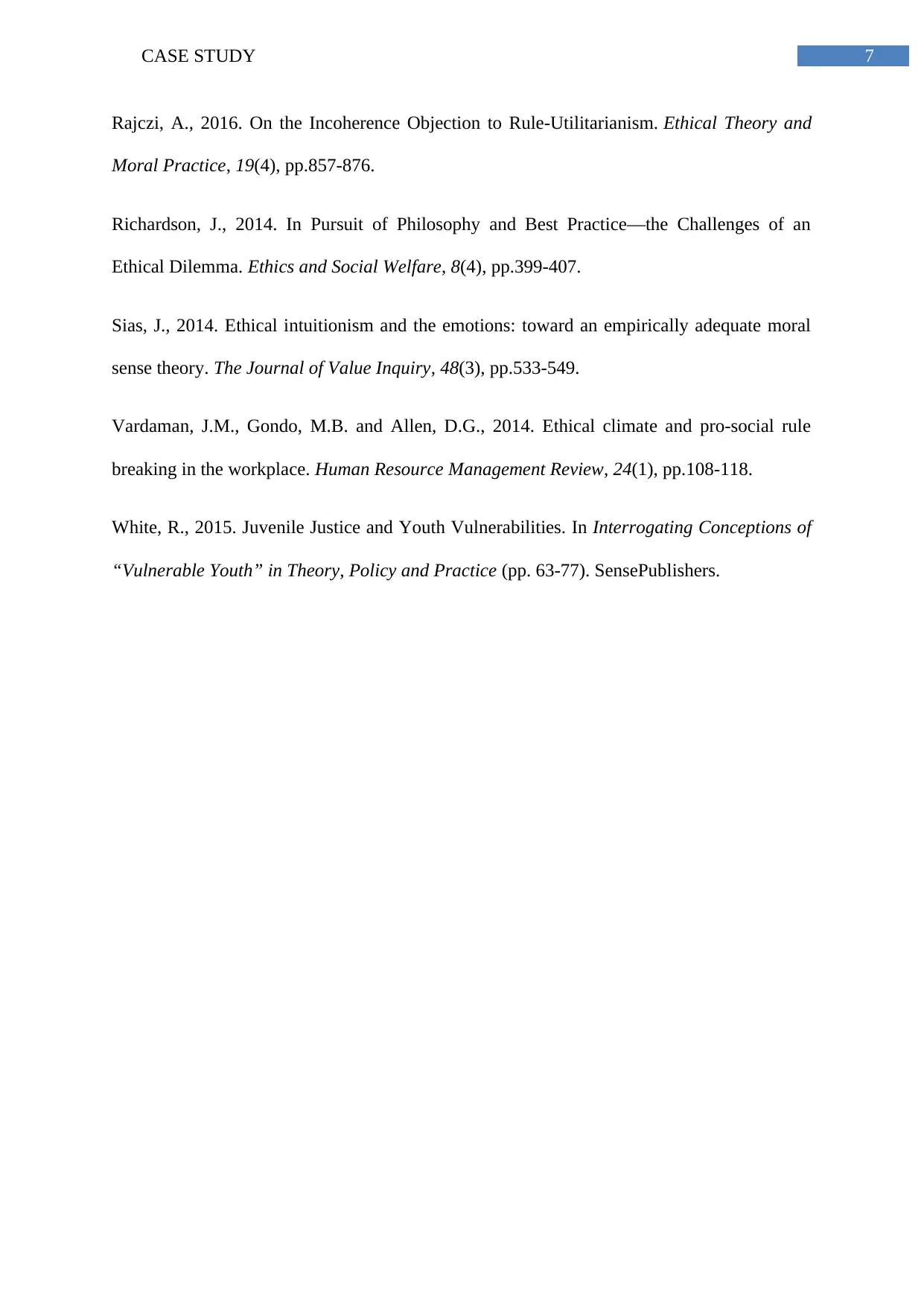
7CASE STUDY
Rajczi, A., 2016. On the Incoherence Objection to Rule-Utilitarianism. Ethical Theory and
Moral Practice, 19(4), pp.857-876.
Richardson, J., 2014. In Pursuit of Philosophy and Best Practice—the Challenges of an
Ethical Dilemma. Ethics and Social Welfare, 8(4), pp.399-407.
Sias, J., 2014. Ethical intuitionism and the emotions: toward an empirically adequate moral
sense theory. The Journal of Value Inquiry, 48(3), pp.533-549.
Vardaman, J.M., Gondo, M.B. and Allen, D.G., 2014. Ethical climate and pro-social rule
breaking in the workplace. Human Resource Management Review, 24(1), pp.108-118.
White, R., 2015. Juvenile Justice and Youth Vulnerabilities. In Interrogating Conceptions of
“Vulnerable Youth” in Theory, Policy and Practice (pp. 63-77). SensePublishers.
Rajczi, A., 2016. On the Incoherence Objection to Rule-Utilitarianism. Ethical Theory and
Moral Practice, 19(4), pp.857-876.
Richardson, J., 2014. In Pursuit of Philosophy and Best Practice—the Challenges of an
Ethical Dilemma. Ethics and Social Welfare, 8(4), pp.399-407.
Sias, J., 2014. Ethical intuitionism and the emotions: toward an empirically adequate moral
sense theory. The Journal of Value Inquiry, 48(3), pp.533-549.
Vardaman, J.M., Gondo, M.B. and Allen, D.G., 2014. Ethical climate and pro-social rule
breaking in the workplace. Human Resource Management Review, 24(1), pp.108-118.
White, R., 2015. Juvenile Justice and Youth Vulnerabilities. In Interrogating Conceptions of
“Vulnerable Youth” in Theory, Policy and Practice (pp. 63-77). SensePublishers.
1 out of 8
Related Documents
Your All-in-One AI-Powered Toolkit for Academic Success.
+13062052269
info@desklib.com
Available 24*7 on WhatsApp / Email
![[object Object]](/_next/static/media/star-bottom.7253800d.svg)
Unlock your academic potential
Copyright © 2020–2025 A2Z Services. All Rights Reserved. Developed and managed by ZUCOL.





